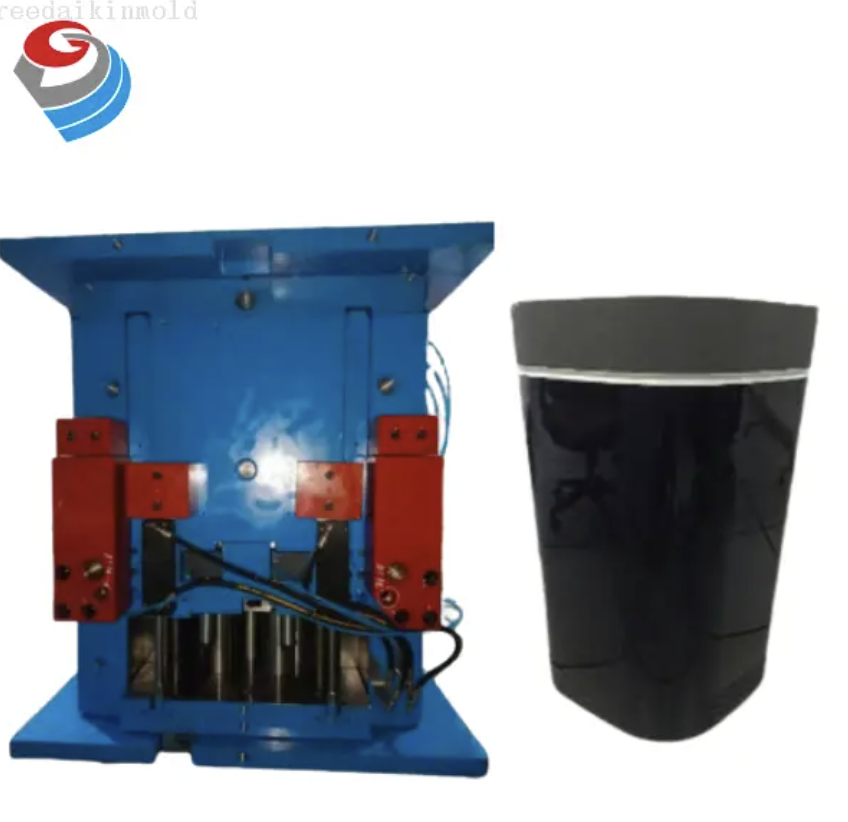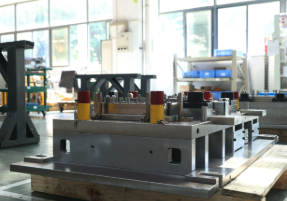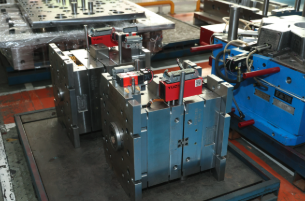Views: 0 Author: Site Editor Publish Time: 2025-07-10 Origin: Site
In a fast-evolving manufacturing landscape, companies face constant pressure to deliver high-quality plastic components quickly and cost-effectively. Aluminum injection molds have become an essential tool for achieving this, enabling manufacturers to reduce lead times, optimize costs, and remain competitive without sacrificing part quality.
For GreeDaikinMold, a precision tooling and mold specialist, aluminum molds align with its commitment to fast, reliable, and precise mold manufacturing, serving industries such as automotive, home appliances, medical devices, and consumer electronics.
Aluminum injection molds are machined mold tools made from high-strength aluminum alloys used in plastic injection molding. They replace conventional tool steels for specific scenarios where speed, flexibility, and reduced upfront investment are critical.
Aluminum molds undergo CNC milling, EDM processing, and precise finishing to create cavities, cores, and parting lines that enable molten plastic to form into finished parts under controlled conditions. Unlike steel molds built for extreme longevity in mass production, aluminum molds excel in rapid prototyping, bridge tooling, and short-to-medium volume runs.

In the evolving landscape of injection mold, aluminum molds are becoming an increasingly popular choice among manufacturers. Traditionally, steel has been the go-to material for injection molds due to its durability and strength. However, advancements in aluminum alloys and machining technologies have positioned aluminum as a viable and often preferable alternative, especially for prototyping, short to medium production runs, and applications requiring rapid turnaround. Below are the key reasons why aluminum injection molds are gaining traction:
Aluminum’s excellent machinability allows for faster cutting speeds and reduced tool wear during the mold-making process. This results in significantly shorter manufacturing times, with aluminum molds typically being delivered 30–60% faster than their steel counterparts. For companies operating under tight project timelines or those looking to accelerate product development cycles, this reduction in lead time is a major advantage. It enables quicker market entry and faster response to consumer demands.
The cost of machining aluminum is generally lower than that of steel due to the reduced machining time and lower tool wear. Consequently, aluminum molds can reduce initial tooling costs by 20–40%, making them an attractive option for startups, research and development departments, and companies testing new product lines. The lower financial barrier also allows for greater experimentation and innovation, as the risk associated with mold investment is minimized.
Aluminum has a thermal conductivity that is 4–5 times higher than steel, meaning it can dissipate heat much more rapidly. This property is particularly beneficial in injection molding, where cooling time can significantly impact cycle time. Faster heat removal from the molded part leads to shorter cooling cycles, thereby reducing overall cycle times and increasing production efficiency. This not only boosts productivity but also contributes to energy savings, as less time is spent waiting for parts to cool.
Due to its machinability, aluminum allows for quicker and more cost-effective design changes or repairs. During the iterative development process, when design adjustments are common, aluminum molds can be easily modified without extensive downtime or cost. This flexibility is invaluable for companies refining product designs or adapting to changing market requirements. It also simplifies maintenance and extends the mold’s useful life, as worn or damaged areas can be readily repaired.
The use of aluminum molds aligns with low-carbon manufacturing goals and Environmental, Social, and Governance (ESG) initiatives. The faster cycle times and reduced energy consumption during both mold fabrication and injection mold contribute to a smaller carbon footprint. Additionally, aluminum is a recyclable material, further enhancing its sustainability profile. Companies focused on environmental responsibility can leverage aluminum molds as part of their green manufacturing strategy.
In summary, aluminum injection molds offer a compelling combination of speed, cost-efficiency, thermal performance, flexibility, and sustainability. These advantages make them an ideal choice for a wide range of applications, from prototyping to full-scale production, particularly in industries where time-to-market and cost control are critical.
Wear Resistance: Aluminum has a lower hardness compared to steel, making it more susceptible to wear when used with abrasive resins such as glass-filled or mineral-filled plastics. This limits its suitability for high-volume runs that require extensive mold life.
Tool Life: The typical lifespan of aluminum molds ranges from 5,000 to 100,000 cycles, which is significantly lower than that of hardened steel molds, often requiring mold replacement or refurbishment sooner, especially in high-wear applications.
Pressure Handling: Aluminum molds may not be suitable for injection processes that involve very high pressures, which are common with certain engineering plastics like PEEK or nylon. Excessive pressure can lead to mold deformation or premature failure.
These limitations can be mitigated by employing smart mold design, such as reinforcing wear-prone areas, using surface coatings (e.g., nickel-plating or anodizing) to improve hardness, and incorporating hybrid tooling where aluminum bases are combined with steel inserts to balance cost and durability.
| Aspect | Aluminum Injection Molds | Steel Injection Molds |
|---|---|---|
| Machining Time | Shorter (30–60% faster) | Longer |
| Initial Cost | Lower | Higher |
| Thermal Conductivity | High | Lower |
| Cycle Time | Shorter | Longer |
| Tool Life | 5,000–100,000 cycles | 100,000–1,000,000+ cycles |
| Weight | Lightweight, easier handling | Heavy, requires cranes for changes |
| Maintenance | Easier, faster modifications | Slower modifications, durable |
| Best For | Prototyping, low-to-medium volume runs | High-volume, high-wear applications |
The table compares aluminum and steel injection molds across key performance aspects. Aluminum molds offer significant advantages in terms of shorter machining times (30–60% faster), lower initial costs, and superior thermal conductivity, resulting in reduced cycle times. They are lightweight, easier to handle, and allow for quicker modifications, making them ideal for prototyping and low-to-medium volume production runs. However, their tool life is generally shorter, ranging from 5,000 to 100,000 cycles. In contrast, steel molds have a longer lifespan, often exceeding 100,000 to over 1,000,000 cycles, and are better suited for high-volume, high-wear applications. While steel molds require longer machining times and higher upfront costs, their durability and resistance to wear make them the preferred choice for long-term production.

Aluminum molds enable fast design validation, user testing, and marketing sampling without the high costs and long lead times associated with steel tooling. This allows companies to quickly iterate on product designs and gather customer feedback before full-scale production.
Aluminum molds serve as bridge tooling during the gap between prototyping and mass production, allowing manufacturers to begin initial production while waiting for steel molds to be completed. This reduces downtime, supports early product launches, and maintains market momentum.
For specialized components in medical devices, consumer electronics, automotive, and industrial products, aluminum molds are ideal for production volumes ranging from hundreds to tens of thousands of units. They provide a cost-effective solution for products with lower annual volumes or customized variants.
Aluminum molds enable design teams to produce functional parts for testing regulatory compliance, assembly fit, and user experience, allowing them to refine product designs and address potential issues before committing to the higher costs of steel tooling for high-volume production.
It is essential to avoid overly thin or fragile sections in aluminum molds to prevent deformation under injection pressure. Maintaining adequate wall thickness and incorporating structural ribs where needed will enhance the mold’s stability and prolong its usable life during repeated cycles.
Take advantage of aluminum’s excellent thermal conductivity by designing efficient and well-placed cooling channels. Optimizing cooling circuits can significantly reduce cycle times, improve part quality by minimizing warpage, and enhance production efficiency, especially for parts with thicker sections.
The gate size and runner layout should be optimized to reduce injection pressure while ensuring complete cavity fill, minimizing the risk of weld lines and voids. Proper gate design also contributes to reducing stress on the mold and extends its life during production.
Applying nickel plating, anodizing, or other hard coatings can increase the wear resistance of aluminum molds, making them suitable for use with mildly abrasive or filled resins. Surface treatments also improve corrosion resistance, which helps maintain consistent surface quality on molded parts.
Using steel inserts in high-wear or critical geometry zones while maintaining an aluminum base combines the speed and cost advantages of aluminum with the durability of steel. This hybrid approach is particularly effective in extending mold life while ensuring performance consistency in areas exposed to high wear or injection pressure.

In the world of manufacturing, the choice between aluminum and steel molds is a critical decision that can significantly impact production efficiency, cost, and product quality. While aluminum molds offer certain advantages, particularly for small-scale production, the majority of users eventually transition to steel molds. This shift is primarily driven by the superior durability, longevity, and cost-effectiveness of steel molds in high-volume manufacturing scenarios.
One of the primary reasons for this transition is the stark difference in mold longevity. Steel molds are renowned for their exceptional durability and ability to withstand the rigors of high-volume production. They can produce millions of parts without significant degradation, making them ideal for large-scale manufacturing. In contrast, aluminum molds, while lighter and easier to machine, are more susceptible to wear and tear. They typically have a lifespan of up to 10,000 parts, which is significantly lower than that of steel molds.
Steel molds are highly resistant to wear and deformation, which is crucial in maintaining consistent part quality over extended production runs. Their robust construction ensures that they can handle the high pressures and temperatures associated with injection molding, resulting in fewer defects and a lower rate of part rejection. This durability not only reduces the frequency of mold replacements but also minimizes downtime, leading to higher overall production efficiency.
Aluminum molds, on the other hand, excel in scenarios where rapid prototyping and short production runs are required. Their lighter weight and easier machinability make them quicker and cheaper to produce, which is advantageous for initial product development and small-batch production. However, their limited lifespan means they are not suitable for long-term, high-volume manufacturing.
Steel molds are particularly well-suited for complex or intricate designs. Their high precision and consistency ensure that even the most detailed features are accurately reproduced in every part. This level of precision is essential in industries such as automotive, aerospace, and electronics, where tight tolerances and high-quality surface finishes are non-negotiable. The ability to maintain these standards across millions of parts makes steel molds the preferred choice for large-scale production.
Steel’s superior wear resistance is another key factor. In high-stress applications, such as injection molding with abrasive materials or high-temperature plastics, steel molds outperform aluminum molds significantly. The longer lifespan of steel molds translates to lower maintenance costs and fewer replacements over time, making them a more cost-effective option in the long run.
While the initial investment in steel molds is higher than that of aluminum molds, the long-term savings are substantial. The extended lifespan and reduced maintenance requirements of steel molds mean that the cost per part decreases significantly over time. This makes steel molds particularly attractive for high-volume production, where the economies of scale can offset the initial expense.
Typically between 5,000 and 100,000 shots depending on design, resin type, and maintenance.
Yes, with advanced CNC machining and EDM, aluminum molds can produce parts with complex geometries, deep ribs, and undercuts.
Absolutely, for low-to-medium production runs where speed and flexibility are valued.
Yes, but resin type and pressure settings must be managed to avoid premature wear.
Yes, by reducing cycle times, energy usage, and material waste while supporting testing of recycled and biodegradable materials.
Aluminum injection molds are a vital asset for manufacturers seeking speed, agility, and efficiency. With benefits like faster lead times, lower initial investment, and excellent thermal performance, they provide a strong solution for rapid prototyping and low-to-medium production scenarios.
For GreeDaikinMold, aluminum molds are not just a tool but a strategy for empowering customers to launch better products faster, supporting iterative design, and ensuring flexibility in dynamic markets. If you’re ready to accelerate your next project, reduce costs, and bring your innovations to market faster, partner with GreeDaikinMold to leverage the power of aluminum injection molds in your manufacturing workflow.
ZHUHAI GREE DAIKIN PRECISION MOLD CO., LTD.